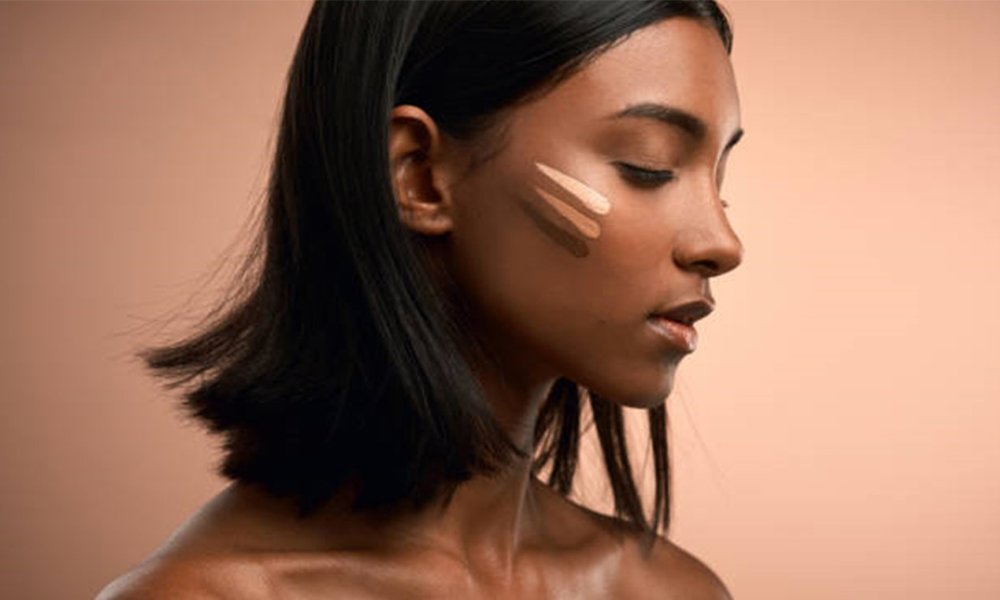Finding the perfect foundation shade can be one of the most difficult parts of your makeup routine. With so many shades, undertones, and formulas to choose from, it can be overwhelming. But once you know your skin tone and undertone, choosing the right foundation becomes much easier. In this blog, we’ll walk you through the steps to help you find your ideal foundation shade and ensure a flawless and natural-looking base.
1. Understand your skin tone
The first step in choosing the right foundation shade is to understand your skin tone. Your skin tone refers to the natural color of your skin, which remains the same year-round. There are generally three main categories of skin tones: fair, medium, and dark.
Fair skin tone: People with fair skin often have pale or porcelain skin. They can get sunburned easily and have pink or neutral undertones.
Medium Skin Tone: Medium skin tones tend to have an olive or golden hue. They can tan easily and have yellow or neutral undertones.

Dark Skin Tone: Dark skin tones are darker shades that range from rich brown to ebony. People with dark skin tones typically have a neutral, red or blue undertone.
Knowing which category you fall into can help narrow down your choices.
2. Identify Your Undertone
In addition to your skin tone, it’s important to understand your undertone. An undertone is the subtle shade beneath the surface of your skin that affects how foundation looks on you. There are three main undertones: cool, warm and neutral.
Cool Undertones: If you have cool undertones, your skin may have a pink, blue or purple hue. People with cool undertones often sunburn easily and have veins that appear blue or purple under their skin.
Warm undertones: Warm undertones have a golden, yellow or peachy hue on the skin. If your veins appear greenish, you probably have warm undertones.
Neutral undertones: Neutral undertones are a mix of cool and warm undertones. If you have a neutral undertone, your veins may have a mix of blue and green and your skin may not have an obvious pink or yellow hue.
Knowing your undertone will help you choose a foundation that complements your natural tone and gives you a more seamless and natural look.

3. Test the foundation shade on your jawline
Once you have an idea of your skin tone and undertone, it’s time to test foundations. The best way to do this is to apply a small amount of foundation to your jawline. This area is ideal because it is near your neck and will give you a more accurate idea of how the foundation will blend with your face and neck.
Apply three different shades of foundation (one lighter, one darker, and one that matches) to your jawline and blend them.
You should choose the shade that blends seamlessly into your skin without being too light or too dark.
Do not test foundation on your wrist or hand as these areas are often a different color than your face.
4. Consider the season
Your skin tone and undertone can change slightly with the seasons. In summer, when you spend more time in the sun, your skin may get a little darker. In winter, your skin may get paler due to less sun exposure. That’s why it’s important to match the shade of your foundation to the season.
Summer: You may need a darker shade of foundation to match your tanned or sunkissed skin.
Winter: If your skin is fairer, you may want to use a slightly lighter shade of foundation to match your winter complexion.
It’s a good idea to have two shades of foundation: one for the warmer months and one for the cooler months.
5. Use the right formula for your skin type
Different foundation formulas work better for different skin types. When choosing a foundation, it’s important to choose one that suits your skin type so it lasts all day and looks natural.
Oily skin: If you have oily skin, choose an oil-free, mattifying foundation. Matte foundations help control shine and keep your skin looking fresh for longer.
Dry skin: For dry skin, choose foundations with a hydrating or dewy finish. These foundations hydrate and don’t settle into dry patches.
Sensitive skin: If you have sensitive skin, opt for fragrance-free and hypoallergenic foundations to avoid irritation.
When choosing your foundation, be sure to pay attention to the formula as it can affect how the product interacts with your skin.

6. Check the foundation under natural light
After applying your foundation, check the color under natural light. Sometimes foundation shades can look different under artificial light, so it’s important to go outside or stand by a window to make sure the color matches your skin tone.
If the foundation looks too yellow, too pink, or too orange under natural light, it’s probably not the right shade for you.
7. Don't forget your neck and chest
Your face isn’t the only area to consider when choosing the right foundation shade. It’s important to blend the foundation onto your neck and chest, especially if your face and neck are different colors. If you find that your face is darker or lighter than your neck, choose a foundation shade that matches your neck for a more even complexion.
8. Try it before you buy it
If you’re still not sure which foundation shade is right for you, many beauty stores offer testers or samples of their products. Take advantage of these free samples before committing to a full-size bottle. It’s always a good idea to test a product for a day to see how it feels and blends with your skin.
Additionally, some beauty brands offer online tools that allow you to find your perfect shade by entering your existing foundation shade or providing a photo. These tools can help you find a starting point before trying the product in person.
Conclusion
Choosing the right foundation shade is an important step in achieving a flawless, natural-looking base. Knowing your skin tone, undertone, and skin type will help you narrow down your options and find a foundation that perfectly complements your complexion. Remember to test foundation shades on your jawline, consider the time of year, and check the color in natural light to ensure the best match. With these tips in mind, you can confidently choose the right foundation shade for your skin and achieve a flawless, radiant look every time.




No Comment! Be the first one.